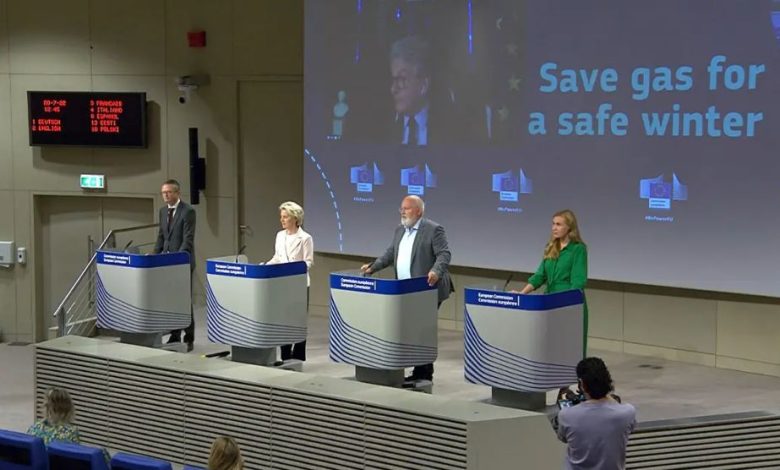New EU Gas Plan saves winter by cutting consumption by 15

Yesterday the Commission has introduced the attended EU Gas Plan
(Sustainabilityenvironment.com) – “We must be proactive and prepare for total cut of gas supplies from Russia. It is a probable scenario”. These are the words of the President of the EU Commission, Ursula von der Leyen, in presenting the new EU Gas Plan, “Save gas for a safe winter”. This is the instrument by which Europe asks the 27 to immediately start reducing gas demand, saving it for the winter.
There are two objectives. One is purely economic: to avoid approaching dangerously the recession zone if a stop to gas from Moscow would result in the halt of industrial production. The impact estimated by the EU executive is 0.6-1.5 GDP points lost.
The other objective is political: to overcome the winter by keeping the European economy afloat will allow the EU to take a stronger position on Ukraine, avoiding being choked by Putin. The measures already presented with the Repower EU plan, in fact, should make the continent quite secure from 2023. “Alternative gas supplies to Russia have increased by 35 billion cubic meters since February”, claims von der Leyen, while the new renewable installed capacity reaches 20 GW (replacing 4 billion m3 of Russian gas). Before the invasion of Ukraine, the EU imported about 150 billion m3 of gas annually from Moscow.
All measures of the EU Gas Plan
Let’s see in detail what the EU Gas Plan proposed by the Commission envisages (before becoming definitive, it must receive the Council’s approval):
Voluntary cuts – It’s the central point of the EU Gas Plan, certainly the most politically sensitive. The Commission proposes that demand cuts should be voluntary. Many countries, on the other hand, did not want to be forced to reduce consumption because they have already “done their homework”, that is, they have good levels of storage. But there is a but. Cuts can become mandatory if one of these two conditions is met: a drastic drop in supplies is likely to lead to emergency situations, or at least three countries declare the gas emergency.
Mandatory cuts – To introduce mandatory cuts in gas consumption, the Commission has presented an emergency instrument, in the form of a legislative proposal based on Article 122 of the Lisbon Treaty. In short, if one of the two conditions mentioned is activated, after consulting the Council, the EU executive can declare a European gas alert if voluntary cuts are not sufficient to ensure the balance between supply and demand. The alert makes the cut mandatory for each of the 27.
How much to cut? – The document does not propose predefined quotas country by country but a linear cut. The reduction in gas use should be at least 15% (applied to all EU countries, worth 45 billion cubic meters of gas). The Commission gives the Member States 8 months from 1 August to 31 March 2023. How is the reduction calculated? Baseline value is the average consumption of the last 5 years for the period considered.
National plans – By September, member countries will have to update their emergency plans. The document should indicate the planned measures to cut gas demand, which should be agreed with the Commission before they become operational. Countries must monitor the implementation of the measures and report back to the Commission every 2 months. And, above all, they must draw up a list of priority areas to be asked to stop in an emergency.
Who stops first – The EU gas plan does not identify sectors that must stop activities before others, but gives countries preferential criteria with which to draw up the list that must be included in the national plan. They are 5: how much the field is critical for the society, the impact of a stop on the transnational supply chain (asks also to characterize of the essential industrial players for every field), the potentialities of reduction of the consumption, the damage to the systems in case of stop, and finally economic considerations. Linking all the criteria is the need for close coordination with all the other EU countries.
What to cut? – Two key points. First, citizens and essential services are not subject to mandatory cuts. The measures therefore concentrate mainly on the industrial sector. Secondly, the Commission is proposing three pillars around which the national plans should revolve. The aim is to switch from gas to alternative fuels in industrial use, introduce market-based incentives for companies that reduce consumption (auctions, tenders, “interruptible” contracts, the possibility for industrial players to exchange gas contracts to facilitate the continuity of production), to introduce limits for heating and cooling in public buildings.





